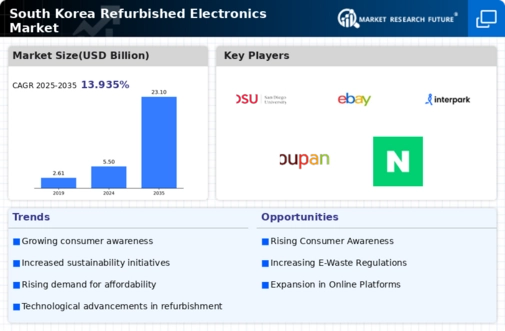Increasing Environmental Awareness
The refurbished electronics market in South Korea is experiencing growth due to rising environmental awareness among consumers. As individuals become more conscious of their ecological footprint, they are increasingly opting for refurbished products as a sustainable alternative to new electronics. This shift in consumer behavior is reflected in a survey indicating that approximately 70% of South Koreans prioritize eco-friendly products. The refurbished electronics market benefits from this trend, as it aligns with the values of environmentally conscious consumers. Furthermore, the government's initiatives to promote recycling and reduce electronic waste further bolster this market. The emphasis on sustainability is likely to continue driving demand for refurbished electronics, as consumers seek to minimize their impact on the environment while still accessing quality technology.
Rising Popularity of E-commerce Platforms
The rising popularity of e-commerce platforms is significantly impacting the refurbished electronics market in South Korea. With the increasing penetration of the internet and mobile devices, consumers are turning to online shopping for convenience and variety. E-commerce platforms provide a wide range of refurbished products, making it easier for consumers to compare prices and quality. This accessibility is crucial for the refurbished electronics market, as it allows consumers to make informed purchasing decisions. Furthermore, many e-commerce platforms are implementing robust return policies and warranties for refurbished items, which enhances consumer confidence. As online shopping continues to grow, the refurbished electronics market is likely to benefit from increased visibility and sales opportunities.
Cost-Effectiveness of Refurbished Products
The cost-effectiveness of refurbished electronics is a significant driver for the market in South Korea. Consumers are increasingly aware of the financial benefits associated with purchasing refurbished items, which can be up to 30-50% cheaper than their brand-new counterparts. This price advantage makes refurbished electronics an attractive option for budget-conscious consumers, particularly students and young professionals. The refurbished electronics market is capitalizing on this trend, as it provides high-quality products at a fraction of the cost. Additionally, the growing trend of online shopping has made it easier for consumers to access refurbished products, further enhancing their appeal. As economic conditions fluctuate, the demand for cost-effective solutions is likely to persist, ensuring continued growth in the refurbished electronics market.
Technological Advancements in Refurbishment Processes
Technological advancements in refurbishment processes are playing a crucial role in the growth of the refurbished electronics market in South Korea. Innovations in testing, repairing, and certifying refurbished products have significantly improved their quality and reliability. For instance, the implementation of advanced diagnostic tools allows refurbishers to ensure that products meet high standards before reaching consumers. This enhancement in quality assurance is vital for building consumer trust in the refurbished electronics market. Moreover, as technology continues to evolve, the efficiency of refurbishment processes is likely to improve, reducing costs and turnaround times. This could lead to a broader range of products being available in the market, appealing to a wider audience and potentially increasing market share.
Government Regulations Promoting Refurbished Electronics
Government regulations in South Korea are increasingly favoring the refurbished electronics market. Policies aimed at reducing electronic waste and promoting recycling are encouraging consumers and businesses to consider refurbished products as viable alternatives. The government has introduced incentives for companies that engage in refurbishment and recycling, which is likely to stimulate growth in the refurbished electronics market. Additionally, educational campaigns aimed at informing the public about the benefits of refurbished products are gaining traction. These initiatives not only enhance consumer awareness but also create a more favorable environment for the refurbishment sector. As regulations continue to evolve, the market may see an uptick in both supply and demand for refurbished electronics.















Leave a Comment